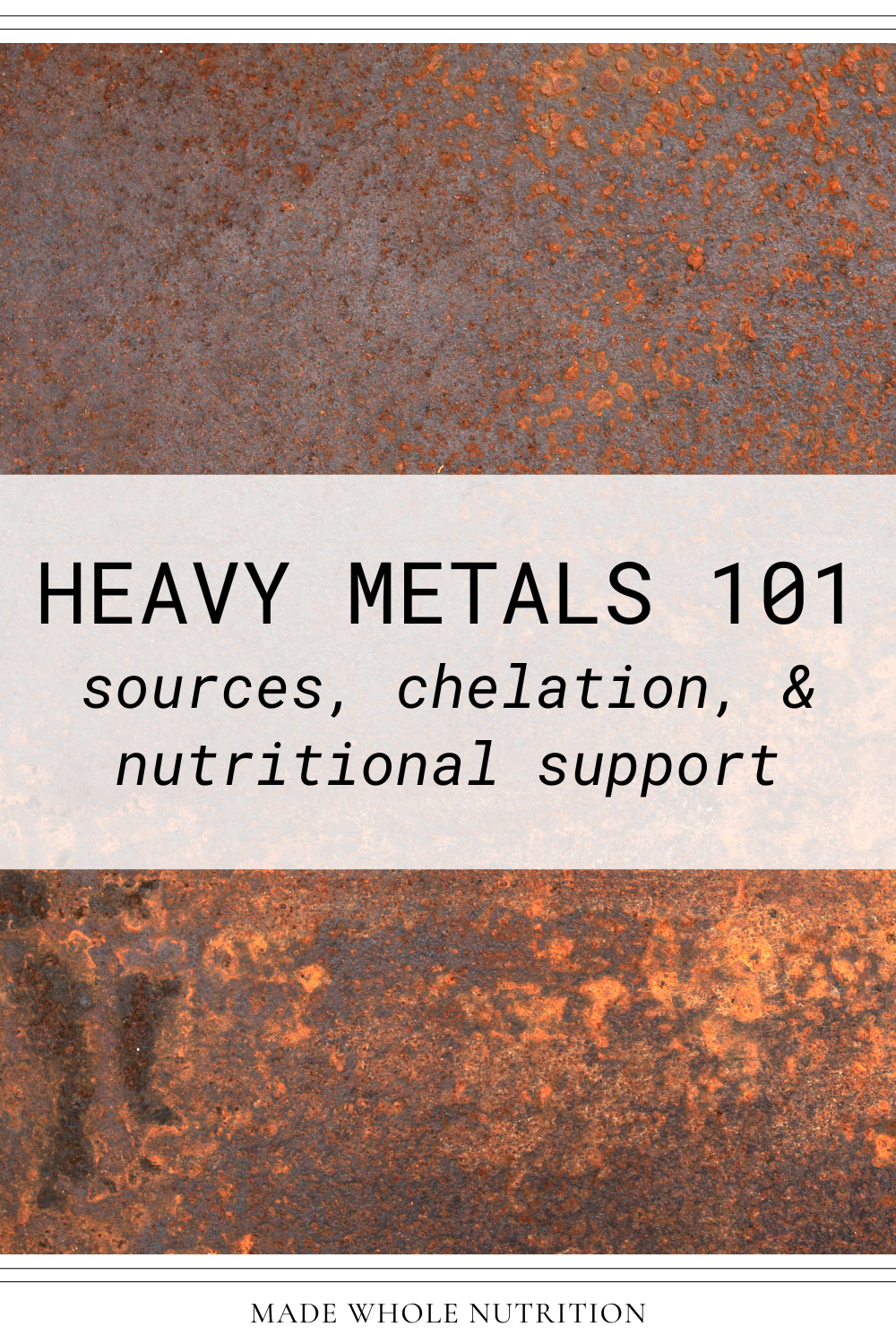HEAVY METALS 101: sources, chelation, & nutritional support
WHAT ARE HEAVY METALS? (not the music)
Lead, arsenic, mercury, cadmium, and aluminum are the heavy metals of most concern to human health.
Even very small amounts can cause serious consequences.
They compete with other essential minerals, leading to nutrient deficiencies, gut dysbiosis, decreased bone density, anemia, enzyme & hormone dysfunction, DNA & mitochondria damage, impaired nerve signaling, and cell death.
SOURCES OF HEAVY METALS
FOOD*, WATER, AIR
*Fish, seafood, & crops grown in contaminated soil are primary dietary sources of heavy metals.
industrial waste
fertilizers
metal pipes
old paint
IUDs
dental fillings
vaccines
deodorant
supplements
cookware
occupational exposure
NOTE: Most exposure from these sources is "below the tolerable limit", meaning it will not result in acute toxicity. However, each can contribute to cumulative levels in the body OR have low-dose effects on hormone receptors.
SHOULD I BE CONCERNED ABOUT HEAVY METALS?
Chronic exposure or impaired detoxification of heavy metals can result in a build-up in the liver, heart, and brain.
Each individual has a different capacity to store and detoxify these minerals before they become problematic.
At that point, toxicity can manifest as nausea, headaches, gut issues, joint pain, muscle weakness, or conditions like dementia, diabetes, autoimmunity, cardiovascular disease, and cancer.
SUPPORTING MINERAL BALANCE
You can support healthy mineral balance by decreasing heavy metal exposure, supporting regular detoxification, and maximizing your dietary intake of antioxidants & minerals.
SUPPORT METAL DETOX
KEEP THINGS MOVING
EAT A DETOXIFYING DIET
full of colorful plant foods, fiber, and quality protein
NUTRITIONAL CHELATION
with activated charcoal, Lactobacillus probiotics, and botanicals like parsley, spirulina, chlorella, garlic, turmeric, black cumin, & coriander
What about chelation therapy?
Chelation involves administration of a chemical agent to bind heavy metal ions, which "deactivates" and allows them to be eliminated.
This procedure is best used to treat acute toxicity. Some use chemical chelation for chronic toxicity, but it has risks.
Chelation therapy should be used with caution, as it can displace other minerals and/or aggravate symptoms, especially if the liver & gut cannot handle the flood of released metals.
Are you a health coach that wants to use this content with your clients? Customize the handout template in less time than it would take to even think about hiring a graphic designer.
References
Bist, P., & Choudhary, S. (2022). Impact of Heavy Metal Toxicity on the Gut Microbiota and Its Relationship with Metabolites and Future Probiotics Strategy: a Review. Biological Trace Element Research, 1–23. https://doi-org.uws.idm.oclc.org/10.1007/s12011-021-03092-4
Collado-López, S., Betanzos-Robledo, L., Téllez-Rojo, M. M., Lamadrid-Figueroa, H., Reyes, M., Ríos, C., & Cantoral, A. (2022). Heavy Metals in Unprocessed or Minimally Processed Foods Consumed by Humans Worldwide: A Scoping Review. International Journal of Environmental Research and Public Health, 19(14). https://doi-org.uws.idm.oclc.org/10.3390/ijerph19148651
El Zayat M, Smith E. Modeling of heavy metals removal from aqueous solution using activated carbon produced from cotton stalk. Water Sci Technol. 2013;67(7):1612-9. doi: 10.2166/wst.2013.037. PMID: 23552252.
Gaby, A. R. (2017). Nutritional Medicine (2nd ed.). Fritz Perlberg Publishing.
Gupta, V. K., Singh, S., Agrawal, A., Siddiqi, N. J., & Sharma, B. (2015). Phytochemicals Mediated Remediation of Neurotoxicity Induced by Heavy Metals. Biochemistry research international, 2015, 534769. https://doi-org.uws.idm.oclc.org/10.1155/2015/534769
Jaishankar, M., Tseten, T., Anbalagan, N., Mathew, B. B., & Beeregowda, K. N. (2014). Toxicity, mechanism and health effects of some heavy metals. Interdisciplinary toxicology, 7(2), 60–72. https://doi-org.uws.idm.oclc.org/10.2478/intox-2014-0009
Lamas, G. A., Navas-Acien, A., Mark, D. B., & Lee, K. L. (2016). Heavy Metals, Cardiovascular Disease, and the Unexpected Benefits of Chelation Therapy. Journal of the American College of Cardiology (JACC), 67(20), 2411–2418. https://doi-org.uws.idm.oclc.org/10.1016/j.jacc.2016.02.066
Maodaa, S. N., Allam, A. A., Ajarem, J., Abdel-Maksoud, M. A., Al-Basher, G. I., & Wang, Z. Y. (2016). Effect of parsley (Petroselinum crispum, Apiaceae) juice against cadmium neurotoxicity in albino mice (Mus Musculus). Behavioral and Brain Functions, 12(6). https://doi-org.uws.idm.oclc.org/10.1186/s12993-016-0090-3
Saif MJ, Zia KM, Fazal-ur-Rehman, Usman M, Hussain AI, Chatha SA. Removal of Heavy Metals by Adsorption onto Activated Carbon Derived from Pine Cones of Pinus roxburghii. Water Environ Res. 2015 Apr;87(4):291-7. doi: 10.2175/106143015X14212658613433. PMID: 26462072.
Saper, R.B., Phillips, R.S., Sehgal, A., Khouri, N., Davis, R.B., Paquin, J., Thuppil, V., & Kales S.N. (2008, Aug 27). Lead, mercury, and arsenic in US-and Indian-manufactured Ayurvedic medicines sold via the Internet. JAMA 300(8), 915-23.
Singh, N., & Sharma, B. (2021). On the Mechanisms of Heavy Metal-Induced Neurotoxicity: Amelioration by Plant Products. Proceedings of the National Academy of Sciences, India Section B: Biological Sciences, 91(4), 743–751. https://doi-org.uws.idm.oclc.org/10.1007/s40011-021-01272-9
Vellingiri, B., Suriyanarayanan, A., Abraham, K. S., Venkatesan, D., Iyer, M., Raj, N., & Gopalakrishnan, A. V. (2022). Influence of heavy metals in Parkinson’s disease: an overview. Journal of Neurology, 1–14. https://doi-org.uws.idm.oclc.org/10.1007/s00415-022-11282-w



